- India - the land of diverse cultures, religions
and faiths is home to equally fascinating traditions and rituals. One of the
most noticeable aspects of India is the diverse attire spanning its humongous
landscape. And one of the most strikingly impressive elements of the attire is
the headgear or headdress. Let us explore some interesting aspects of the
headgear/turban/pagdi worn by men.
Why do Indians wear a
headgear?
First things first … let’s get to the root of the tradition.
Climatic reasons
Sweltering summers, bitter winters,
dust, humidity and penetrating sunlight are no strangers to most of the Indian
sub-continent, except the southern states where humidity and heat are the
ruling climatic conditions all-year-round. Hence, in earlier times, protection
from climatic and weather conditions was an important reason for wearing the pagdi.
However, with time, city folk came to adopt a more acceptable and hassle-free
western attire, leaving the Indian headdress out of their daily lives. Today,
the traditional pagdi is largely worn only on festivals, religious ceremonies
and special occasions such as weddings and so on except the Sikh community for
whom it is part of their attire.
Since turbans are more associated with
Sikhs today, not to say that other Indians do not sport turbans, we shall start
with the Sikh tradition.
Why did Sikh start wearing
turbans?
It must be understood that Sikhs started
sporting turbans only after 1699. Here is why -
Sanjeev Nayyar, founder of www.esamskriti.com wrote, “On 30 March 1699, at Anandpur, the 10th Guru Govind Singhji gave a stirring speech to the assembly about the need to protect their spiritual and temporal rights. He then asked if anyone would offer his head in the services of God, Truth and Religion. The five came forward were designated the Five “Beloved Ones” and termed “Khalsa” (i.e. Purified).
According to Khalsa tradition, its
followers had to sport the five Ks i.e. Kesh (long hair), Kangha (comb), Kirpan
(sword), Kara (steel bracelet), Kachcha (knickers).
Since Sikhs are not supposed to cut
their hair (some Sikhs do ie beyond the scope of this article) the turban helps
them manage the hair and keep it clean. However in 1699 the reason was
different. Long hair and turban helped the Guru identify his followers and
importantly protect their face and head from sword cuts and lathi blows.
Every K had a reason. The Kara was a reminder that the Sikh spirit was strong and unbending. The kachcha was more suitable for fighting the Mughals in than the dhotis and loose trousers of the Muslims. The Kara was also useful in hand to hand fights and “guarded the vulnerable portion of the right hand which wielded the kripan”.
According to a devout Sikh lady, other reasons for the five k's “was the need to look ferocious like Mughal soldiers. Nobody could run away from the battlefield as they could be immediately identified and soldiers were always ready for battle.” 1
Today young boys wear a simple piece of
fabric over their tied-up hair, called a patka.
According to Sanjeev Nayyar his great
grand-father who lived in Punjab around 1948 wore a pagdi too. On asking, his
Dadaji said that generation wore pagdis. It may be those born 1900 onwards
(like Dadaji) were exposed to British style education and thus gave up
traditional ways.
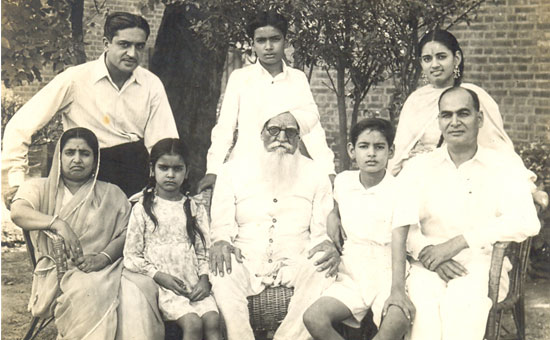 Editor’s great grand-father in centre of pic.
Editor’s great grand-father in centre of pic.
Social and ritualistic reasons
In most North Indian communities there
is an exchange of Pagadis between families indicating a close friendship or a
dear relationship for generations to come. Such is the value and importance of
the Pagdi, that once it is knocked over, it means insult and lost pride.
Handing over your Pagadi is also considered compete surrender, in many
communities. In many communities upon the death of the head of the family, his
eldest son is made to wear the turban signifying his position as the new family
head. The custom is called Rasam Pagari
and takes place a few days after death. While in a few, a man handing over the Pagadi
to a woman indicates the death of her husband.
Different types of Pagdis
Let us start with the Sikhs.
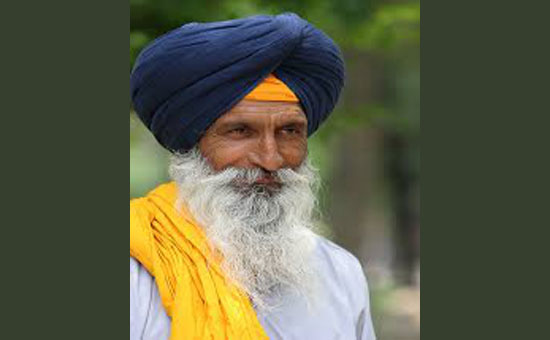 The Sikh Dastaar
The Sikh Dastaar
The Sikh turban, called the ‘Dastaar’ is worn in many ways. A larger, rounder dastaar is called a Dumaala – a style that symbolizes valor and courage, while a smaller rounder turban tied together with a printer and checkered cloth is called a Parna. The Naamdhari pagdi
is a flat, coif-like turban which is tier horizontally across the forehead with
the ears of the person lying completely outside the turban. This is also called
the Sidhi Dastaar. The Pagh, a style that most people are
familiar with is the one that symbolizes pride and belief. It is more angular
in shape as compared to the other styles. There is also the Nihang style. Also, young Sikh boys
cover their bun of hair with a Patka – a bandana or a rectangular cloth ties around their heads.
With style forming an increasing part of
our lives the turban has gone through its share of evolution. Some more
interesting information on the Sikh turban.
According to this stylishly made
video the turban types also include Amritsar Shahi, Folk Bhangra,
Morni and Patila Shahi Pag.
G S Dhaliwal wrote in www.quora.com – “The Patiala shahi is the one with steps
on both sides. The original (barnala
shahi) - the one in a triangular shape with one side with steps and the other plain. The Rough style-currently in fashion, it's actually a patiala shahi turban tied without stretching the cloth to make it plain so it’s a rough patiala shahi. The dumala - it's a kind of turban that is just rolled around the head in circles and kinda goes up”.
According to this India Today
report four Sikhs talk about the different style of
turbans namely the Nok turban ie influenced by the Malwa
style. In Namdhari style “Pritpal Singh ties a white, round Naamdhari which is a flat, coif-like turban. Known as the Sidhi Dastaar (straight turban), this turban is tied horizontally across the forehead, with the turban-bearer's ears lying completely outside the turban.
One is not clear if there are different
styles in different regions of Punjab.
The next state where turbans are very
popular is the colorful state of Rajasthan.
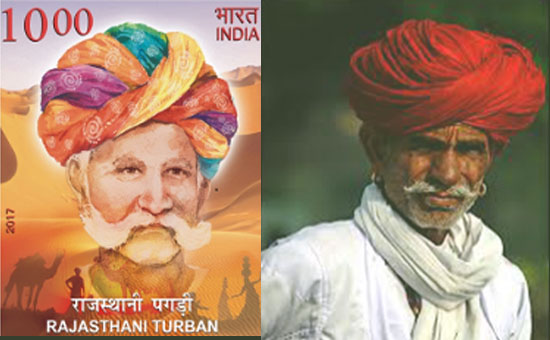 Rajasthani Safa
Rajasthani Safa
The archetypal Rajasthani Pagari or Pagdi
or Safa is the symbol of Marwari pride, honor and valor. Different styles of
pagdis are indicated by the color of the cloth used for tying them. The spring
heralds a splash of color and the Safa that matches this sentiment is the Falgunia – turbans having white and red designs. Motiya pagdi indicating pearl pink color is common during the month of
July which a month of seasonal transition. Monsoon, scanty as ever in
Rajasthan, is also celebrated and the color of the pagdi during this season is Lehariya – bright green, yellow, orange, red and blue stripes.
Apart from these seasonal flairs the
Rajasthani Pagadi implies other things. According to a board at the Patwa ki
Havali Jaisalmer colour of turban indicates the community. There white means
Bishnoi, white safa is Jat, bright
red is Raika, colourful checkered is Langiya, Kalbeliya and Manganair print
safa, five colored turban or saffron colored kesariya turban means Rajput
(called Pachrangi Pagdis), White
means Ram snehi community, Red is Kabir community and Ochre coloured is Sanyasi
community.
Different regions of Rajasthan for eg
Mewar, Marwar have different ways of tying a turban for eg the article cover
picture is a Mewar style turban.
Let us move to the east ie Bihar.
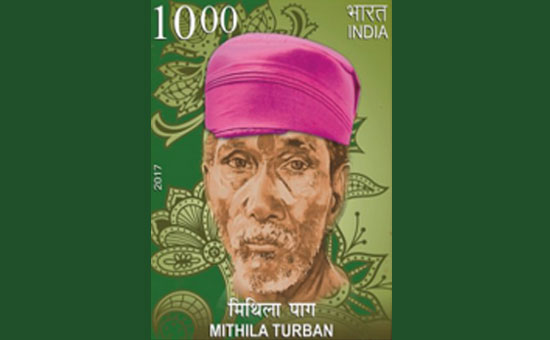 Paag from Bihar
Paag from Bihar
The Paag
is a simple headdress that originated in the Mithila region of Bihar and is a
symbol of pride and respect.
Coming to the west is the Maharashtrian Peta.
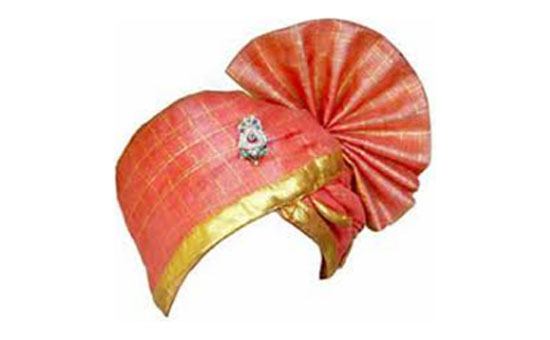
Maharashtrians commonly wear either a
saffron (indicating valor) or a white (indicating peace) Pheta apart from the
colorful one on traditional functions and religious ceremonies. Most popular
among the styles of Maharashtrian turbans is Puneri (worn by people of Pune), Kolhapuri (worn by the royals of Kolhapur) and Mawali (worn by the
mawalas, or Maratha warriors). The Phule Pagadi
worn by the great social reformer Mahatma Jyotiba Phule is popular too.
Let us visit Mysore in the state of
Karnataka.
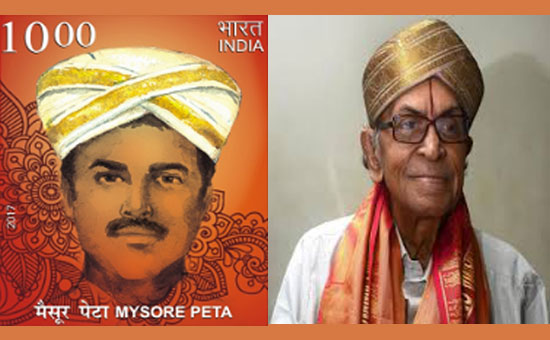 The Mysore Peta
The Mysore Peta
The Mysore Peta is a traditional
indigenous turban worn by the Wodeyar kings, the erstwhile rulers of Mysore and
Kodagu regions of Karnataka. This is one of the most illustrious and
prestigious headgears made of high quality silk and jari i.e. now exalted to
heritage status.
Other Indian headgears: Among the other
not-so-commonly heard of headgears include Jaapi
from Assam – a traditional hat made of tightly-woven bamboo or cane. The Jaapi is worn by Assamese men during the traditional Bihu dance and other religious ceremonies. Another one is the Himachali cap. Every region of
Himachal Pradesh has a unique cap in a distinct color and is part of their
identity.
The Naga
Tsula, a one-of-a kind headdress in India, symbolizes either heredity, position, power or status among the tribal people of Nagaland. The headdress is made up of hornbill bird’s beak, animal skulls, boar tusks and feather, and other elements typical to the region.
What type of Turbans do grooms wear across India? Source www.tamarindweddings.com
“The Ladakhi groom wears heavy woolen attire along with an elaborately decorated turban called the ‘tibi’. The ‘Kinnauri’ groom of Himachal Pradesh covers his head with a silver head ornament called ‘mulamentho,’ similar to his bride’s. It flows from the head to the neck on both sides of the face and hosts a bunch of silver leaves attached to a triangular plaque. A complex lattice design sticks to this plaque.”
“The Sikh groom always comes with his usual turban called ‘pagri’ or ‘dastar’. However, on his big day, he ties it differently; as a pagri is either red or pink, the groom’s wedding attire will be in contrast with it. The Marwari groom from Rajasthan ties a red turban called ‘safa’, adorned with the traditional ‘kalgi’ and ‘sarpech.”
From personal
experience say that currently during Punjabi Hindu weddings family members of
both sides wear a pagdi. If groom side choses pink (usual colour) bride family
will have a different colour.
“In South, only the Kannada and the Reddy grooms give importance to headgears. Mysore Peta is the traditional headgear of a Kannada groom and they wear it on any important or formal event. It is a single piece of cloth decorated with gold brocade and zari border. Often, they have beautiful metal pendants sewn onto them, adding flavour of grandeur and lavishness. The Reddy groom too shows the typical South Indian favour for gold, by wearing a royal-looking white and gold turban with a ‘bashingam’ on the forehead.”
“The Bengali groom wears a white ‘topor’, a conical turban made of sholapith (a fragile soft pith plant). There are lots of local beliefs associated with this turban. The Bihari groom wears a red silk cloth on his head. Meanwhile, in Jharkhand where there are many tribes, the groom wears a simple white turban. The Oriya groom and bride wear the same turban – a majestic crown decorated with multi-coloured stones, beads and paisley motifs.
In the East most interesting is the turban of the Assamese groom. “He comes with either a tulsi mala or a crown made of fresh flowers. The Manipuri groom covers his head with a white turban called the ‘kokyet’, edged with golden braiding. Other popular turbans are the traditional colourful tribal headgears using beads, cowries, feathers and bamboo spikes. These are used in tribal marriages.” 3
Also read
1 Variety of headgear in the Indian subcontinent
2 Nihang Sikh Turban
3 Multi-turban Indian grooms